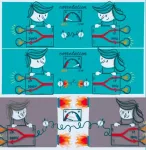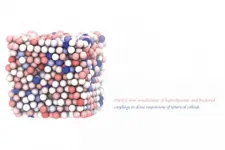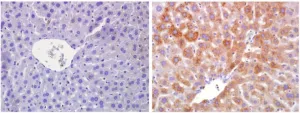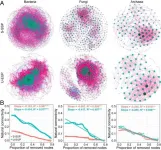Measuring the elimination of plastic particles from the body in mice
2021-06-16
(Press-News.org) Postdoctoral Researcher Outi Keinänen from the University of Helsinki developed a method to radiolabel plastic particles in order to observe their biodistribution on the basis of radioactivity with the help of positron emission tomography (PET). As a radiochemist, Keinänen has in her previous radiopharmaceutical studies utilised PET imaging combined with computed tomography (CT), which produces a very accurate image of the anatomical location of the radioactivity signal.
In the recently completed study, radiolabelled plastic particles were fed to mice, and their elimination from the body was followed with PET-CT scans. This was the first time that the movement and location of plastic particles in a living mammalian system were observed in real time.
The study utilised polystyrene particles of four different sizes: 20 nm, 220 nm, 1 μm and 6 μm. The journey of the radiolabelled plastic particles through the gastrointestinal tract was followed for two days (48 hours) through PET-CT scans.
The study, which was recently published in Scientific Reports journal, demonstrated that most of the particles had been eliminated from the mice naturally, through faeces within two days. Not much translocation of plastic particles from the gastrointestinal tract to elsewhere in the body was seen, and the smallest particles were eliminated from the body at a faster rate than the larger ones.
In addition to PET imaging, the findings were verified by thoroughly measuring the radioactivity of the tissues and organs of the mice. The persistence of the radiolabel on the surface of the plastic particles was verified by collecting murine gastrointestinal tracts at several different time points after administering the particles. The gastrointestinal tracts of mice that were put down at different timepoints were cut open, ground and separated into several fractions based on size. The share of the non-attached radiolabel was very small compared to the radiolabel still attached to the plastic particles. This was proof that the monitored radiation signal described the passage of the plastic particles well.
First and foremost, the study surveyed the usefulness of PET imaging in the study of micro- and nanoplastics, demonstrating that PET imaging enables accurate and non-invasive observation of plastic particles in living animals. Consequently, PET imaging may well become an important element of investigations into the health effects of plastics on mammals.
"While only a single small dose of polystyrene particles was fed to the mice, people are exposed daily to a range of micro- and nanoplastics. Therefore, we cannot draw direct conclusions on the accumulation of plastics in mammals and their effects on the basis of this study alone," Keinänen notes.
"In addition to ingesting plastics, the air we breathe contains small particles of plastic. Further studies are in fact in the pipeline," Keinänen promises.
Next up, the researchers wish to investigate the long-term consequences of daily exposure to micro- and nanoplastics, as well as the accumulation of inhaled plastic particles in mice. In future projects, the aim is to use different plastic materials in addition to polystyrene, the type of plastic used in this study.
INFORMATION:
Article:
Keinänen, O., Dayts, E.J., Rodriguez, C. et al. Harnessing PET to track micro- and nanoplastics in vivo. Scientific Reports 11, 11463 (2021). https://doi.org/10.1038/s41598-021-90929-6
Further information:
Outi Keinänen, postdoctoral researcher
University of Helsinki
phone: +1 347 254 0421
email: outi.keinanen@helsinki.fi
[Attachments] See images for this press release:

ELSE PRESS RELEASES FROM THIS DATE:
2021-06-16
Research published today in the Journal of General Virology has identified missed cases of SARS-CoV-2 by retrospective testing of throat swabs.
Researchers at the University of Nottingham screened 1,660 routine diagnostic specimens which had been collected at a Nottingham hospital between 2 January and 11 March 2020 and tested for SARS-CoV-2 by PCR. At this stage of the pandemic, there was very little COVID-19 testing available in hospitals, and to qualify patients had to meet a strict criterion, including recent travel to certain countries in Asia or contact with a known positive case.
Three previously unidentified cases of SARS-CoV-2 infection were identified by the retrospective screening, including one from a 75-year-old ...
2021-06-16
The phenomenon of quantum nonlocality defies our everyday intuition. It shows the strong correlations between several quantum particles some of which change their state instantaneously when the others are measured, regardless of the distance between them. While this phenomenon has been confirmed for slow moving particles, it has been debated whether nonlocality is preserved when particles move very fast at velocities close to the speed of light, and even more so when those velocities are quantum mechanically indefinite. Now, researchers from the University of Vienna, the Austrian Academy of Sciences and the Perimeter Institute report in the latest issue of Physical Review Letters that ...
2021-06-16
Tokyo, Japan - Colloids--mixtures of particles made from one substance, dispersed in another substance--crop up in numerous areas of everyday life, including cosmetics, food and dyes, and form important systems within our bodies. Understanding the behavior of colloids therefore has wide-ranging implications, yet investigating the rotation of spherical particles has been challenging. Now, an international team including researchers from The University of Tokyo Institute of Industrial Science has created particles with an off-center core or "eye" that can be tracked ...
2021-06-16
Getting energy and nutrients from the environment - that is, eating - is such an important function that it has been regulated through sophisticated mechanisms over hundreds of millions of years. Some of these mechanisms are only now beginning to be unravelled. A group at the Spanish National Cancer Research Centre (CNIO) has found one of their key components - a switch that controls the ability of organisms to adapt to low cellular nutrient levels.
The protein involved is RagA, which is part of the mTOR molecular pathway, whose importance in metabolic activity regulation has been known for decades now. CNIO researchers have found that if RagA is continuously activated, cells do not know that there are no sufficient nutrients and so ...
2021-06-16
The encryption algorithm GEA-1 was implemented in mobile phones in the 1990s to encrypt data connections. Since then, it has been kept secret. Now, a research team from Ruhr-Universität Bochum (RUB), together with colleagues from France and Norway, has analysed the algorithm and has come to the following conclusion: GEA-1 is so easy to break that it must be a deliberately weak encryption that was built in as a backdoor. Although the vulnerability is still present in many modern mobile phones, it no longer poses any significant threat to users, according to the researchers.
Backdoors not useful according to researchers
"Even though intelligence services and ministers of the interior understandably want such backdoors ...
2021-06-16
ENVIRONMENT Diesel-polluted soil from now defunct military outposts in Greenland can be remediated using naturally occurring soil bacteria according to an extensive five-year experiment in Mestersvig, East Greenland, to which the University of Copenhagen has contributed.
Mothballed military outposts and stacks of rusting oil drums aren't an unusual sight in Greenland. Indeed, there are about 30 abandoned military installations in Greenland where diesel, once used to keep generators and other machinery running, may have seeped into the ground.
This is the case with Station 9117 Mestersvig, an abandoned military airfield ...
2021-06-16
These findings were published in the journal Cellular and Molecular Life Sciences on 8 June 2021.
Huge splicing diversity in the brain
The human genome was sequenced around 20 years ago. Since then, the sequence information encoding our proteins is known - at least in principle. However, this information is not continuously stored in the individual genes, but is divided into smaller coding sections. These coding sections, also known as exons, are assembled in a process called splicing. Depending on the gene, different exon combinations are possible, which is why they are referred to as different or ...
2021-06-16
With increasing vaccination rates and decreasing numbers of infections, the population's feeling of safety is also rising. As the results of the 37th edition of the BfR-Corona-Monitor, a regular survey conducted by the German Federal Institute for Risk Assessment (BfR), show, the majority of the population in Germany thinks it can control its risk of an infection well. "62 percent are confident that they can protect themselves from an infection with the coronavirus," says BfR-President Professor Dr. Dr. Andreas Hensel. "We see that the feeling of safety has increased considerably. ...
2021-06-16
Chinese researchers have recently discovered links between reduction in microbial stability and soil carbon loss in the active layer of degraded alpine permafrost on the Qinghai-Tibet Plateau (QTP).
The researchers, headed by Prof. CHEN Shengyun from the Northwest Institute of Eco-Environment and Resources (NIEER) of the Chinese Academy of Sciences (CAS), and XUE Kai from University of Chinese Academy of Sciences, conducted a combined in-depth analysis of soil microbial communities and their co-occurrence networks in the active permafrost layer along an extensive gradient of permafrost degradation.
The QTP encompasses the largest extent of high-altitude mountain ...
2021-06-16
Greater Helsinki -- Transitioning to low-carbon energy production is the biggest climate challenge to overcome. Many countries are already looking to adopt clean heating solutions more widely, with the International Energy Agency projecting that by 2045 nearly half of global heating will be done with heat pumps. To ensure speedy uptake, governments are likely to offer subsidies to ensure these energy-efficient options actually make their way into homes and offices.
A new study from Aalto University assesses the impact of heat pumps on energy consumption as well as how ...
LAST 30 PRESS RELEASES:
[Press-News.org] Measuring the elimination of plastic particles from the body in mice






